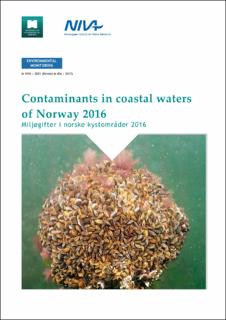Contaminants in coastal waters of Norway 2016
| dc.contributor.author | Green, Norman Whitaker | |
| dc.contributor.author | Schøyen, Merete | |
| dc.contributor.author | Øxnevad, Sigurd | |
| dc.contributor.author | Ruus, Anders | |
| dc.contributor.author | Hjermann, Dag Øystein | |
| dc.contributor.author | Severinsen, Gunnar | |
| dc.contributor.author | Høgåsen, Tore | |
| dc.contributor.author | Beylich, Bjørnar | |
| dc.contributor.author | Håvardstun, Jarle | |
| dc.contributor.author | Lund, Espen | |
| dc.contributor.author | Tveiten, Lise Ann | |
| dc.contributor.author | Bæk, Kine | |
| dc.date.accessioned | 2018-04-04T06:47:35Z | |
| dc.date.available | 2018-04-04T06:47:35Z | |
| dc.date.created | 2018-04-03T15:28:47Z | |
| dc.date.issued | 2021 | |
| dc.identifier.isbn | 978-82-577-7314-4 | |
| dc.identifier.issn | 1894-7948 | |
| dc.identifier.uri | http://hdl.handle.net/11250/2492447 | |
| dc.description | Revised version of 7200-2017 / M-856 | nb_NO |
| dc.description.abstract | This programme examines the levels, trends and effects of contaminants in biota along the coast of Norway. The 2016- investigation included analyses of 104 different contaminants or biological effect parameters in five types of samples (blue mussel, dog whelk, common periwinkle and cod). The contaminants include metals (Hg, Cd, Pb, Cu, Zn, Ag, As, Ni, Cr and Co), tributyltin (TBT), organochlorines (e.g. PCBs, DDT), PAHs, polybrominated diphenyl ethers (PBDEs), perfluorinated alkylated substances (PFAS) as well as contaminants that have recently received much attention such as hexabromocyclododecane (HBCDs), chlorinated paraffins (SCCP, MCCP), phosphorus flame retardants (PFRs), bisphenol A (BPA), tetrabrombisphenol A (TBBPA) and alkyphenols. Biological effects parameters included VDSI, OH-pyrene metabolites, ALA-D and EROD. In the report, 30 representative substances or parameters were chosen for analyses of 800 time series (last 10 years). Of these there were statistically significant trends in 135 cases: 107 were downwards and 28 upwards. The dominance of downward trends indicated that contamination is decreasing for the measured substances. The downwards trends for TBT-concentrations and effect parameter (VDSI) confirmed that the legislation banning the use of TBT has been effective. Of the 2016-medians for all 800 time series, there were 403 cases that could be classified against EQS, of which 254 (63 %) were below the EQS and 149 (37 %) were above the EQS. All of the 2016-medians from the 800 time series could be classified using a new concept denoted provisional high reference concentrations (PROREF). Of these 594 were below PROREF and 206 exceeded PROREF: 124 by a factor of less than two, 59 by a factor between two and five, 11 by a factor between five and 10, six by a factor between 10 and 20, and six by a factor greater than 20. Some cases warrant special concern, such as high concentrations of several organic pollutants in cod liver from the Inner Oslofjord. High concentrations of DDE in mussels from the Sørfjord were related to earlier use of DDT as pesticide in orchards along the fjord. The influence of fish length on contaminant concentration was examined. Results of analyses of stable isotopes of carbon and nitrogen are presented to investigate the role of food origin and trophic levels for observed contaminant concentrations. | nb_NO |
| dc.description.sponsorship | Norwegian Environment Agency | nb_NO |
| dc.language.iso | eng | nb_NO |
| dc.publisher | Norsk institutt for vannforskning | nb_NO |
| dc.relation.ispartof | NIVA-rapport | |
| dc.relation.ispartofseries | NIVA-rapport;7579 | |
| dc.relation.ispartofseries | Miljødirektoratet-rapport;1935 | |
| dc.rights | Navngivelse-Ikkekommersiell-DelPåSammeVilkår 4.0 Internasjonal | * |
| dc.rights.uri | http://creativecommons.org/licenses/by-nc-sa/4.0/deed.no | * |
| dc.subject | Norge | nb_NO |
| dc.subject | Norway | nb_NO |
| dc.subject | Miljøgifter | nb_NO |
| dc.subject | Environmental pollution | nb_NO |
| dc.subject | Biologiske effekter | nb_NO |
| dc.subject | Biological effects | nb_NO |
| dc.subject | Marin | nb_NO |
| dc.subject | Marine | nb_NO |
| dc.title | Contaminants in coastal waters of Norway 2016 | nb_NO |
| dc.type | Research report | nb_NO |
| dc.description.version | publishedVersion | nb_NO |
| dc.rights.holder | Norwegian Institute of Water Research | nb_NO |
| dc.subject.nsi | VDP::Matematikk og naturvitenskap: 400 | nb_NO |
| dc.subject.nsi | VDP::Mathematics and natural scienses: 400 | nb_NO |
| dc.source.pagenumber | 198 | nb_NO |
| dc.source.issue | 7579 | nb_NO |
| dc.identifier.cristin | 1576958 | |
| dc.relation.project | 16330/17330 | nb_NO |
| cristin.unitcode | 7464,20,12,0 | |
| cristin.unitcode | 7464,20,14,0 | |
| cristin.unitcode | 7464,20,17,0 | |
| cristin.unitcode | 7464,20,18,0 | |
| cristin.unitcode | 7464,30,12,0 | |
| cristin.unitcode | 7464,20,11,0 | |
| cristin.unitcode | 7464,30,21,0 | |
| cristin.unitname | Marin forurensning | |
| cristin.unitname | Marin biogeokjemi og oseanografi | |
| cristin.unitname | Forskningsinfrastruktur | |
| cristin.unitname | Miljøinformatikk | |
| cristin.unitname | Akvatiske miljøgifter | |
| cristin.unitname | Marin biologi | |
| cristin.unitname | Miljøkjemi | |
| cristin.ispublished | true | |
| cristin.fulltext | original |
Tilhørende fil(er)
Denne innførselen finnes i følgende samling(er)
-
NIVA-rapporter [6996]
-
Publikasjoner fra Cristin - NIVA [2150]

